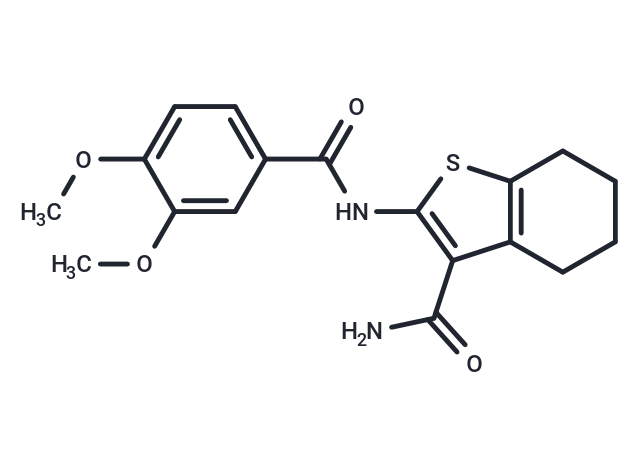Shopping Cart
- Remove All
 Your shopping cart is currently empty
Your shopping cart is currently empty

TCS 359 (FLT3 Inhibitor) is a potent FLT3 inhibitor with IC50 of 42 nM.

| Pack Size | Price | Availability | Quantity |
|---|---|---|---|
| 5 mg | $31 | In Stock | |
| 10 mg | $48 | In Stock | |
| 25 mg | $94 | In Stock | |
| 50 mg | $158 | In Stock | |
| 100 mg | $205 | In Stock |
| Description | TCS 359 (FLT3 Inhibitor) is a potent FLT3 inhibitor with IC50 of 42 nM. |
| Targets&IC50 | FLT3:42 nM |
| In vitro | TCS 359, a 2-acylaminothiophene-3-carboxamide, is a potent inhibitor of FLT3 with IC50 of 42 nM. TCS 359 inhibits MV4-11 proliferation with IC50 of 340 nM. TCS 359 is highly selective for FLT3 against a panel of kinases. [1] |
| Kinase Assay | Affinity determination: To determine the activity of the compounds of the present invention in an in vitro kinase assay, inhibition of the isolated kinase domain of the human FLT3 receptor is performed using the following fluorescence polarization (FP) protocol. The FLT3 fluorescence polarization assay utilizes the fluorescein-labeled phosphopeptide and the anti-phosphotyrosine antibody included in the Panvera Phospho-Tyrosine Kinase Kit. The FLT3 kinase reaction is incubated at room temperature for 30 min under the following conditions: 10 nM FLT3 571-993, 20μg/mL poly Glu4Tyr, 150 μM ATP, 5 mM MgCl2, and 1% compound in DMSO. The kinase reaction is stopped with the addition of EDTA. The fluorescein-labeled phosphopeptide and the anti-phosphotyrosine antibody are added and incubated for 30 min at room temperature and polarization is read. |
| Cell Research | MV4-11 cells are plated at 10,000 cells per well in 100 μL of in RPMI media containing penn/strep, 10% FBS, and 0.2 ng/mL GM-CSF. Compound dilutions or 0.1% DMSO (vehicle control) is added to cells and the cells are allowed to grow for 72 h at standard cell growth conditions. To measure total cell growth, an equal volume of CellTiterGlo reagent is added to each well and luminescence is quantified. Total cell growth is quantified as the difference in luminescent counts of cell number at Day 0 compared to total cell number at Day 3 (72 h of growth and/or compound treatment). All IC50 values are calculated in GraphPadPrism using non-linear regression analysis with a multiparameter (variable slope) equation.(Only for Reference) |
| Alias | FLT3 Inhibitor |
| Molecular Weight | 360.43 |
| Formula | C18H20N2O4S |
| Cas No. | 301305-73-7 |
| Smiles | COc1ccc(cc1OC)C(=O)Nc1sc2CCCCc2c1C(N)=O |
| Relative Density. | 1.328g/cm3 |
| Storage | Powder: -20°C for 3 years | In solvent: -80°C for 1 year | Shipping with blue ice. | |||||||||||||||||||||||||
| Solubility Information | DMSO: 10.8 mg/mL (29.96 mM), Sonication is recommended. | |||||||||||||||||||||||||
Solution Preparation Table | ||||||||||||||||||||||||||
DMSO
| ||||||||||||||||||||||||||

Copyright © 2015-2025 TargetMol Chemicals Inc. All Rights Reserved.